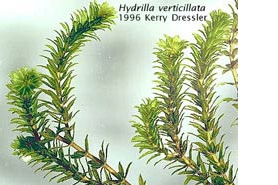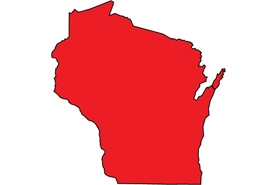Hydrilla
(Hydrilla verticillata)
Hydrilla, a submerged perennial, is the most troublesome aquatic plant in the United States. It outcompetes native vegetation, acts as a breeding ground for mosquitoes and destroys fish and wildlife. It is among the marine species on the federal noxious weed list.
Other names for this plant include:
- Common names: water thyme, Florida elodea
- Scientific names: Hydrilla asiatica; H. japonica; H. lithuanica; H. ovalifolica
Classification in Wisconsin: Prohibited
- Ecological Threat
-
- It invades lakes, ponds, reservoirs, rivers and ditches. Generally found rooted at the bottom of 20’ or more fresh, slow-moving or still water.
- It acts as a breeding ground for mosquitoes and destroys fish and wildlife. Water intake and delivery systems can also be severely impacted.
- Identification
-
Leaves: In whorls of 3-10 around the stem at nodes; 0.75” long and 0.25” wide; small spines give leaf margins a toothed appearance; midrib is often spiny below and reddish when new; lack stems; rough to the touch.
Flowers: Tiny; female flowers are white, in leaf axils, and have six petals on long, thread-like stalks; male flowers are green and look like inverted bells.
Fruits & seeds: Loment-like, narrowly cylindrical, 5-15 mm long, smooth or with few to several short to long irregular spines, do not open to release seeds; seeds 1-5, ellipsoid, 2-3 mm long, smooth, brown.
Roots: Reproduces by rhizomatous tubers.
Similar species: Similar characteristics to other aquatic plants, including Brazilian waterweed and the native Canadian waterweed. It also resembles Elodea canadensis, but Hydrilla can be distinguished from Elodea by the presence of tubers, leaves in whorls around the stem, serrations or small spines along the leaf edges, and the reddish midrib of a fresh leaf.
- Distribution
-
Currently, there have been no reports of hydrilla in Wisconsin. Have you seen it? Please send us a report.
- Control
-
Mechanical: Specialized machines are used for mechanically removing Hydrilla, but because of the high cost involved (often over $1,000 per acre) and because of logistical constraints, the practice isn’t widespread. Up to six harvests may be required annually due to the rapid growth rate of Hydrilla. Mechanical removal is used for management only in areas close to domestic water supply intakes, in rapidly flowing water, or when immediate removal is necessary.
Drawdowns can be effective for control if done in the fall and before regrowth in the spring. But, even in drained lakes and ponds, subterranean turions may remain dormant and viable in organic substrates.
Chemical: The aquatic herbicides, copper sulfate, fluridone and endothall have been used effectively for control.
Biological: Studies are being conducted for whether sterile grass carp, certain snails and certain insects would be successful biological control agents. Still, no excellent biological control agents are known to exist now.
- Resources
- Sources for content:
- Czarapata, Elizabeth; Invasive Plants of the Upper Midwest: an illustrated guide to their identification and control. The University of Wisconsin Press. 2005. Pg. 145
- Lake Tides (UW Extension Lakes Program publication) article: Hydrilla? Don’t you mean Godzilla? [exit DNR]
- Batcher, Michael S. The Nature Conservancy Element Stewardship Abstract for Hydrilla verticillata [exit DNR]


